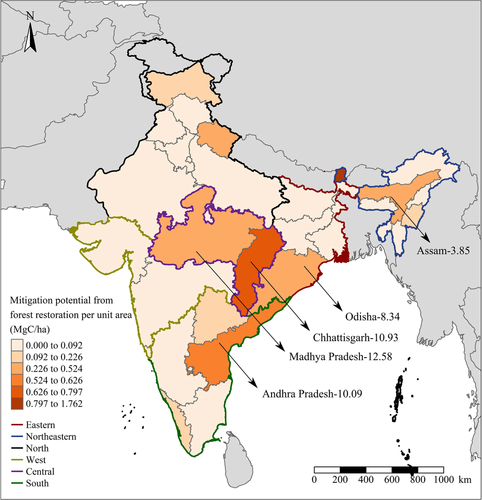A new study by Oxford India Centre for Sustainable Development scholar Trisha Gopalakrishna and co-authors found that the additional mitigation potential from forest restoration in India was less than a quarter of the country’s commitments to the Paris Agreement in 2015.
The current forest area of India spans over 71 million hectares (Mha) according to Forest Survey of India 2019 Report. Trisha’s study focusses on scoping out additional areas suitable for forest restoration, where forests would act as carbon sinks for climate change mitigation. “There are no estimates yet for where forest restoration can be done in India – only targets that the government has proposed,” said Trisha, who is a DPhil candidate at the School of Geography and the Environment, University of Oxford. “So the aim of the study was to map where this opportunity exists.”
Trisha and her co-authors from the University of Oxford, University of Exeter, University of Hyderabad and Jawaharlal Nehru University used a machine learning framework to define areas that could naturally sustain forests. The study also accounted for varying land use such as agriculture, and land cover like grasslands, savannahs and wetlands. The main finding was that the additional areas available for agroforestry was very small compared to global India-specific estimates and India’s forest restoration commitments at the Paris Summit. In other words, India’s commitments overestimate the area available and the mitigation potential of forest restoration.
The study estimated the additional feasible area for forest restoration to be 1.58 million hectares, cumulatively sequestering 61.3 TgC or tera grams of carbon, which is substantially less than estimates from global studies. This amounts to only 19.5-23.4% of India’s Land Use, Land Use Change and Forestry pledge to the Paris Agreement.
“Many global studies have made ambitious pledges to increase forest areas to mitigate climate change,” said Trisha. “But while these studies indicate substantial potential, they do not consider local and regional variation of land-use and land cover.” For example, the study shows that central Indian states of Chhattisgarh and Madhya Pradesh have the highest additional feasible area, while Goa in western India and Mizoram in the north-east have the least additional feasible area.

Mitigation potential of forest restoration normalized by total area of each state (MgC/ha) (no agroforestry).
The paper suggests that this information is crucial for better-informed decision and policy-making at the national and subnational scales.
“This finding underscores that forest restoration and agroforestry can only be one of many strategies fundamental to meet the goals of the Paris Agreement and that substantial greenhouse gas emission reductions will be needed by other sectors, most importantly, energy,” write the authors in the new paper. “Moving ahead, we recommend further research to investigate not only the total area available for forest restoration and agroforestry, but also social and cultural dimensions like forest governance and land tenure issues because of historical and current land use legacies, and other factors associated with the political economy of specific forest restoration scheme.”
“This information will also help prioritize policies, enable financial resources, and guide on-the-ground implementation activities in the upcoming UN Decade of Restoration.”
The full paper can be accessed (without firewall) here: https://conbio.onlinelibrary.wiley.com/doi/10.1111/conl.12867